Arcturus, Alpha Boötis (α Boo), is a red giant star located 36.7 light-years away in the northern constellation Boötes. With an apparent magnitude of -0.05, it is the brightest star in Boötes and the 4th brightest star in the sky.
Arcturus is the brightest star in the northern celestial hemisphere, just outshining Vega and Capella. The giant star is only fainter than the three exceptionally bright southern stars, Sirius, Canopus, and Alpha Centauri.
Arcturus is part of three prominent spring asterisms, the Spring Triangle, the Great Diamond, and the Kite of Boötes. The star can be found using the handle of the Big Dipper.
Star type
Arcturus is a giant star of the spectral type K1.5IIIFe-0.5. It is the brightest class K giant in the sky, outshining Aldebaran (mag. 0.86) in the constellation Taurus and Pollux (mag. 1.14) in Gemini. It has an absolute magnitude of about -0.30.
With an estimated age of 7.1 billion years, Arcturus is a bit older than the Sun (4.5 billion years). It is also more evolved, having exhausted the supply of hydrogen in its core, moved off the main sequence, and expanded into a giant. It has about the same mass as the Sun (1.08 solar masses), but has grown to 25.4 times its size. The star has an estimated surface temperature of 4,286 K and is 170 times more luminous than the Sun.
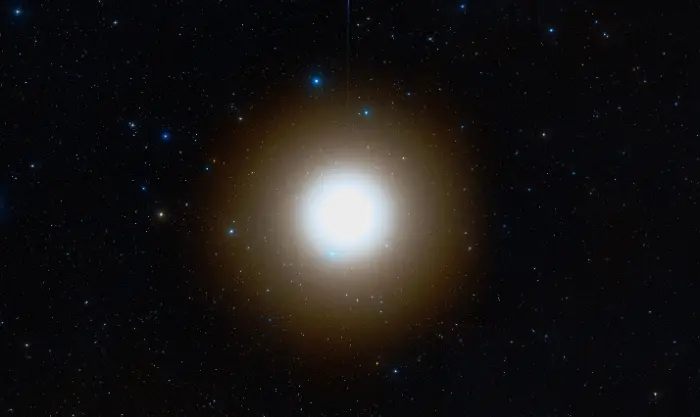
Arcturus (Alpha Boötis), image: Wikisky
Arcturus is currently on the red giant branch (RGB). RGB stars are low- to intermediate-mass stars that have evolved away from the main sequence but have not yet started fusing helium in their cores. Also known as the first giant branch, this evolutionary stage is characterized by an inert helium core surrounded by a shell in which hydrogen fusion occurs via the CNO (carbon-nitrogen-oxygen) cycle.
As the hydrogen shell produces more helium, the core will increase in mass and temperature, causing the hydrogen shell to fuse more rapidly. At this point, red giants become larger, cooler, and more luminous. They are said to be ascending the red giant branch. Once they begin fusing helium in an event known as the helium flash, they become hotter and less luminous, and they move to the horizontal branch.
Arcturus does not have any known companions, which means that its mass cannot be measured directly. The estimated value of 1.08 ± 0.06 solar masses is based on evolutionary modelling and observed physical properties. A 2012 analysis of Arcturus and Aldebaran’s carbon and oxygen isotopic ratios yielded a slightly higher value of 1.2 solar masses.
The star has also been the subject of asteroseismological measurements, which allow direct calculation of its mass, but the current modelling is not considered accurate. It is, however, useful for comparison with other methods. The measurements yielded values of 0.8 ± 0.2 solar masses and 27.9 ± 3.4 solar radii.
Arcturus is not massive enough to go out as a supernova. Instead, it will end its life by casting out its outer shell to form a planetary nebula and slowly fade away as a compact white dwarf. The Sun will share its fate billions of years from now.
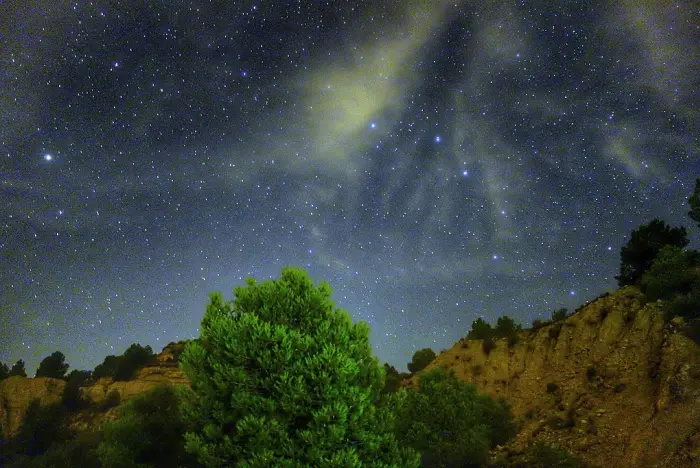
Arcturus (lleft) and the Big Dipper (right), image credit: Free Photos, CCO (CC0 1.0)
The estimated age of Arcturus is in the range from 6 to 8.5 billion years, but the star’s evolutionary phase is uncertain. The colour index indicates that it has entered the red giant branch and the hydrogen shell burning stage after exhausting the supply of hydrogen in its core. As it keeps ascending the red giant branch, some of the helium left in its core will be compacted into degenerate matter, which will increase the core’s density and temperature. Once the temperature reaches about 100 million K, it will ignite the helium, starting helium fusion in the core. This will increase the temperature which, in turn, will increase the fusion rate, triggering a runaway reaction that will produce a helium flash, a very brief flash of intense helium fusion that lasts only for a few minutes, but has an energy output comparable to that of out entire galaxy.
However, a study by Charbonnel et al. published in 1998 suggested that the star has already moved past the helium flash stage and is above the horizontal branch (core helium phase burning stage in metal-poor stars).
Arcturus only has a third of the Sun’s metallicity, but it has a higher ratio of alpha elements (oxygen, silicon, neon, etc.) relative to iron and is suspected to be a Population II star, formed from the gas that emerged right after the big bang, during an earlier time of the universe. These stars are very rare in the Sun’s neighbourhood, making up only 4% of all stars in the vicinity of the solar system.
Arcturus has a high proper motion – about 2 arcseconds per year – because it is located only 36.7 light years away. The only first magnitude star with a higher proper motion is Alpha Centauri, the nearest star system to Earth at 4.37 light years.
The proper motion of Arcturus was discovered by the English astronomer Sir Edmond Halley in 1718. Halley compared his astrometric measurements to those given by the Greco-Roman astronomer Ptolemy in the 2nd century CE and found that Arcturus, Sirius and Procyon had shifted in the sky since ancient times. This realization led to the discovery of proper motion in what were previously believed to be “fixed” stars.
Arcturus has a parallax of 88.83 milliarcseconds per year with a margin of error of 0.54 milliarcseconds. This yields a distance margin of error of 0.23 light years.
The Hipparcos satellite data suggests that Arcturus may be a binary star with a companion in a tight orbit. The proposed companion is about 20 times fainter than Arcturus and its being in a close orbit makes the star exceptionally difficult to make out. A study published in 2005 did not confirm its existence, but it supported the Hipparcos data, stating that analysis of the data obtained from near-infrared interferometric measurements suggested the presence of a subgiant companion.
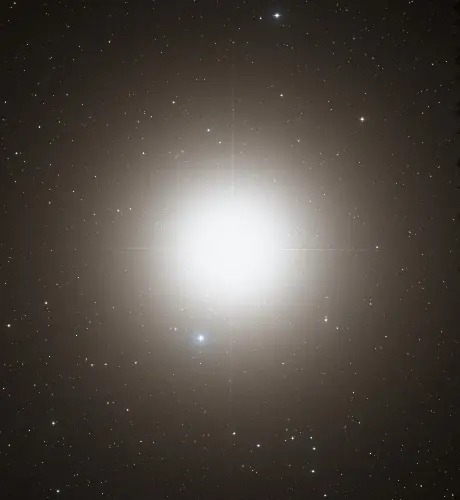
Optical image of Arcturus provided via the Mikulski Archive for Space Telescopes (MAST), STScI, and NASA
Luminosity
Arcturus is one of the most luminous stars in our neighbourhood. In visible light, its energy output is 110 times that of the Sun, but much of the star’s output is in infrared wavelengths because it has a lower surface temperature than the Sun. Its total luminosity amounts to about 180 times solar.
Arcturus has a J band magnitude of -2.2. In near-infrared wavelengths, it is fainter only than the red supergiant Betelgeuse (-2.9) in the constellation Orion and the red giant Mira variable star R Doradus (-2.6) in Dorado.
Size
Arcturus has a radius 25.4 times that of the Sun. While it is by no means tiny, it is smaller than many other giant stars, including the fellow orange giant Aldebaran (44.13 R☉) and the red giant Gacrux (84 R☉). It is also larger than a number of stars with the luminosity class III, including the orange giants Pollux (8.8 R☉) and Unukalhai (12 R☉), the yellow giant Capella (11.98 R☉), and the blue-white giant Hadar (13 R☉).
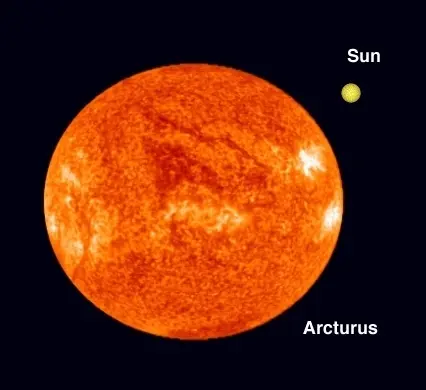
Size comparison of Arcturus and the Sun, image credit: Windows to the Universe
However, it does not even come close in size to supergiant stars like Betelgeuse (887 R☉), Antares (680 – 800 R☉), and Deneb (203 R☉), let alone to the record holders, the red supergiants UY Scuti (1,708 R☉) and Stephenson 2-18 (2,150 R☉).
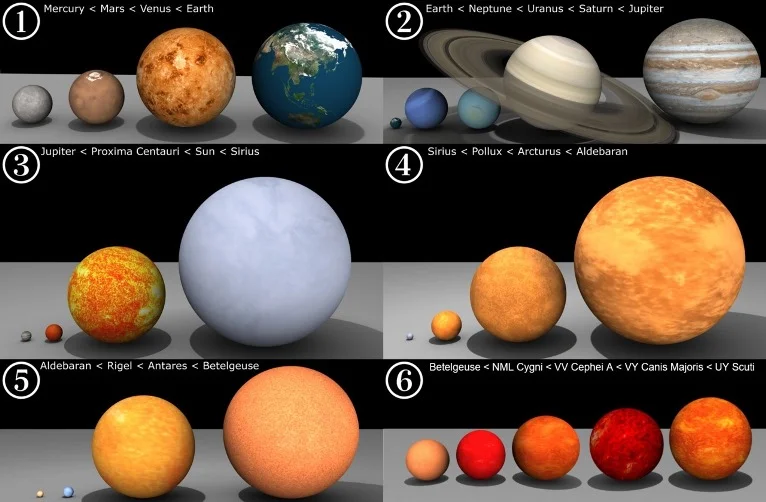
Size comparison of planets and stars, image: Wikimedia Commons/ Dave Jarvis, Jcpag2012, JoeyPknowsalotaboutthat (CC BY-SA 4.0)
Planet
In 1993, Arcturus, Pollux and Aldebaran were the subjects of a study that measured the radial velocities of the three orange giants. A team of scientists at University of Texas at Austin found long-period variations in the relative radial velocities of all three stars, indicating the presence of a substellar companion. The hypothetical companion would have almost 12 Jupiter masses and orbit Arcturus from a distance of 1.1 astronomical units, almost the same as the distance from the Earth to the Sun. However, a companion has not yet been confirmed for Arcturus. The authors of the study concluded that the radial velocity variations (with a period of 233 days) in Arcturus were likely intrinsic to the star (due to pulsations, rotational modulation or chromospheric heating) and not caused by the gravity of an orbiting companion.
Facts
Arcturus is usually listed as the fourth brightest star in the sky because it is only outshined by Sirius, Canopus and Alpha Centauri. However, Alpha Centauri AB consists of two components – Rigil Kentaurus (Alpha Centauri A) and Toliman (Alpha Centauri B) – both of which are fainter than Arcturus, even though their combined magnitude is -0.27. Alpha Centauri A has an apparent magnitude of +0.01 and Alpha Centauri B, +1.33, while Arcturus shines at magnitude -0.05. This makes Arcturus the third individual brightest star in the sky.
Arcturus forms three conspicuous asterisms with other bright stars in this region of the sky. It forms the Spring Triangle with Spica in the constellation Virgo and Regulus in Leo. The elongated triangle dominates the evening sky during the northern hemisphere spring.
Arcturus and Spica also form the Great Diamond (the Diamond of Virgo) with Denebola in the constellation Leo and Cor Caroli in Canes Venatici. The two asterisms can be used to find the many relatively bright deep sky objects that lie within their borders, including the Virgo Cluster of galaxies.
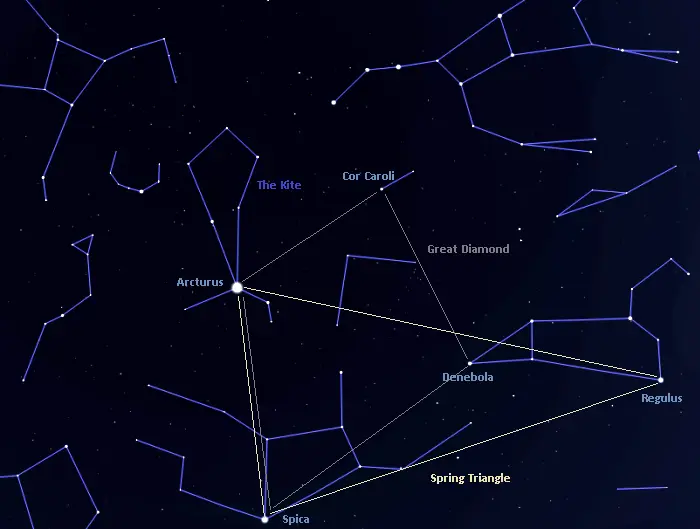
Spring Triangle, the Diamond of Virgo and the Kite, image: Stellarium
The Kite is fainter and less prominent, but it can be made out between the handle of the Big Dipper and the semi-circle formed by the brightest stars in the constellation Corona Borealis (the Northern Crown) on a clear night. The asterism is formed by Arcturus with Izar (Epsilon Boötis), Delta Boötis, Nekkar (Beta Boötis), Seginus (Gamma Boötis), and Rho Boötis. Some observers add Eta, Tau, Upsilon and Zeta Boötis to the asterism to give the Kite a tether and tail.
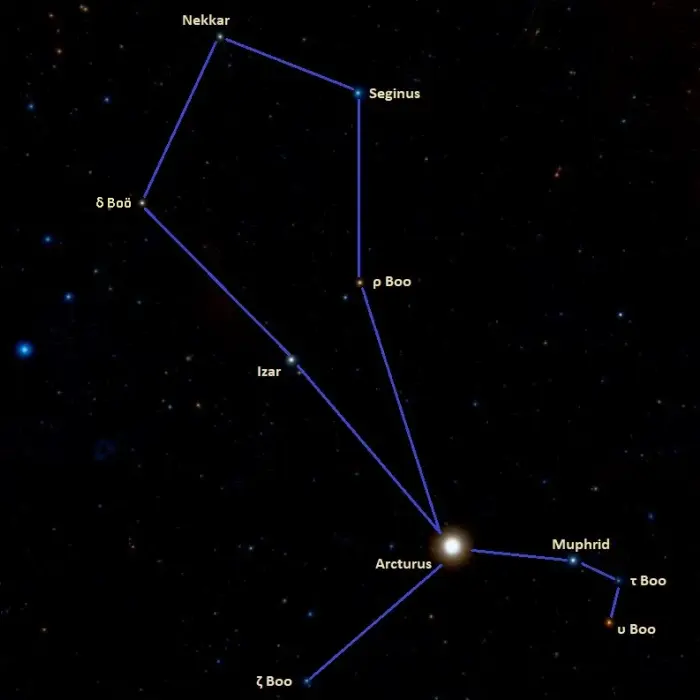
The Kite in Boötes, image: Stellarium
Arcturus is one of the 58 bright stars that have been given a special status in the field of celestial navigation. It is the only navigational star in the constellation Boötes.
Arcturus was not visible from Earth until about half a million years ago. It has been moving in our direction and has now almost reached its closest point to the solar system, moving at 122 km/s relative to the Sun. It will make the closest approach in approximately 4,000 years, when it comes a few hundredths of a light-year closer than it is now. The giant star will then start to move away in a southerly direction and, in another half million years years, it will not be visible to the unaided eye at all.
Arcturus is a member of the Arcturus moving group (Arcturus stream), a group of stars that share similar proper motion and are believed to be physically associated. The group was discovered by American astronomer Olin J. Eggen in 1971. Other members include the red giants Anser (Alpha Vulpeculae) and 27 Cancri, and the orange giant Kappa Gruis.
These are mostly old stars with significantly lower levels of heavy elements, located in the Milky Way’s thick disk. They do not share the same velocities with the stars in the Milky Way plane and are travelling perpendicularly to the Galactic disk. It has been proposed that these stars came from a smaller satellite galaxy that was devoured by the Milky Way a long time ago. However, a different study suggested that there was no difference in the chemical composition of Arcturus stream members and other F- and G-type stars in the solar neighbourhood, indicating that the stars originated in the Milky Way.
Arcturus’ nearest known neighbour is Muphrid, Eta Boötis, a binary star located at almost the same distance from the Sun (37.2 light years), that appears close to Arcturus in the night sky. The two stars are separated by only 3.3 light years. An observer on a hypothetical planet orbiting Arcturus would see Muphrid as a magnitude -2.5 star (roughly the brightness of Mercury), while Arcturus would appear as bright as Venus (mag. -4.92 to -2.98) to an observer on a planet orbiting Muphrid.
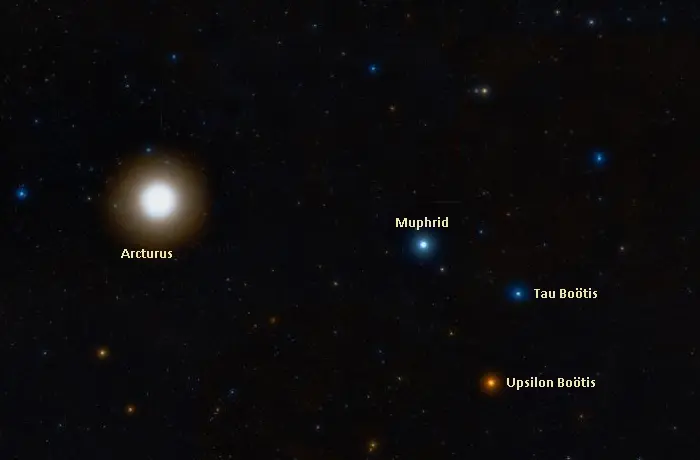
Arcturus and Muphrid, image: Wikisky
The Greco-Roman astronomer Ptolemy described Arcturus as “slightly red” (subrufa). With a B-V colour index of +1.23, Arcturus is about halfway between fellow orange giants Pollux and Aldebaran.
As the brightest orange giant in the sky, Arcturus is used to check and refine current spectral classification systems. The star’s spectrum serves as an important standard in stellar spectroscopy.
Arcturus was the first star other than the Sun and supernovae to be observed during the daytime with a telescope. The French astronomer, mathematician and astrologer Jean-Baptiste Morin was the first person to do it in 1635. Arcturus is occasionally visible to the unaided eye just before the sun sets.
Arcturus has been used and referenced in countless works of fiction. Notable uses in literature include the novels A Voyage to Arcturus (1920) by David Lindsay, What Mad Universe (1946) by Fredric Brown, Isaac Asimov’s Foundation series (1951 – 1993), Gordon R. Dickson’s Alien From Arcturus (1956), Elliot S. Maggin’s Superman: Last Son of Krypton (1978), Douglas Adams’ The Hitchhiker’s Guide to the Galaxy (1978–1992), Stanislaw Lem’s Return from the Stars (1980), Jack Vance’s The Book of Dreams (1981), and John Barnes’ A Million Open Doors (1993).
In film and television, the star was used or referenced in Aliens (1986), Buck Rogers in the 25th century (1979 – 1981), Spaced Invaders (1990) and Passengers (2016).
Name
The name Arcturus comes from the Greek Ἀρκτοῦρος (Arktouros), meaning “keeper of the bear” or “guardian of the bear.” In Greek, ἄρκτος (arktos) means “bear” and οὖρος (ouros) means “guardian” or “watcher.”
Arcturus is the star’s traditional name. It has been used since at least the 8th century BCE, when it was referenced in the works of the Greek poet Hesiod. Hesiod mentioned the star’s rising 50 days after the winter solstice in his book Works and Days (cca 750 BCE).
The name was officially approved by the International Astronomical Union’s (IAU) Working Group on Star Names (WGSN) on June 30, 2016.
Arcturus has been known by many other names in cultures around the world. The Arabic name for the star was as-simāk ar-rāmiħ, meaning “the uplifted one of the lancer.” Arcturus and Spica were the two stars known as “the uplifted ones” (al-simāk), and the name Al Simak Al Ramih appeared in Egyptian astronomer Al Achsasi Al Mouakket’s Calendarium, written around 1650. It was later translated into Latin as Al Simak Lanceator. Other variants derived from this name included Aramec, Azimech and Alramih. Two other Arabic names for Arcturus were haris-el-sema (“the keeper of heaven”) and ħāris al-shamāl’ (“the keeper of north”).
The Chinese know Arcturus as 大角 (Da Jiao), meaning “Great Horn.” It is the brightest star in the constellation Jiao Xiu (角宿), meaning “horn star.” Later, Arcturus became a part of the Chinese Neck mansion, Kang Xiu (亢宿).
The Japanese name for the star is Mugi-boshi (麦星), “star of wheat.”
In Indian astrology, the star is known as Swati, which means “very beneficent” in Sanskrit. It belongs to the lunar mansion of the same name.
The Inuit people know Arcturus by two names, Uttuqalualuk (“old man”) and Sivulliik (“the first ones”).
The Mi’kmaq people of Atlantic Canada called the star Kookoogwéss, meaning “the owl.”
The Wotjobaluk people of Victoria, Australia called it Marpean-kurrk. Marpean-kurrk was the mother of Djuit (Antares) and Weet-kurrk (Muphrid). The appearance of Arcturus in the northern sky signalled the coming of the wood ant larvae (food) every spring, while its setting with the Sun heralded the beginning of summer, when the larvae disappeared. The Weilwan people of New South Wales called the star Guembila, meaning “red.”
In Polynesia, Arcturus was known by several names. In Hawaii, it was called Hoku-leʻa (“star of gladness” or “clear star”) and associated with the constellation Te Kiva, “frigatebird,” which was either Boötes or just Arcturus. The pattern of Boötes was known as Hoku-iwa, or “stars of the frigatebird.” In local lore, Boötes showed the path for Hawaiiloa, the fisherman from an old Hawaiian legend who found the island of Hawaii by accident and settled there, when he returned home from the South Pacific Ocean. In the Hawaiian Islands, Arcturus is the zenith star and, in prehistoric times, Polynesian navigators used it when they set sail from the Marquesas Islands and Tahiti. They knew they had reached the latitude of the islands when Arcturus was directly overhead in the summer. They would keep sailing west, keeping the star overhead, until they reached the Big Island of Hawaii. When they sailed back to Tahiti, they could use Sirius as the island’s zenith star, which allowed them to sail across the Pacific Ocean without instruments.
The people of the Society Islands saw Arcturus as one of the 10 pillars of the sky and called it Ana-tahua-taata-metua-te-tupu-mavae, meaning “a pillar to stand by.” In Tahiti, the 10 pillars were bright stars representing the 10 heavens in the afterlife.
The Māori people of New Zealand knew Arcturus as Tautoru and, in the Marquesas Islands, the star had a similar name, Tau-tou.
Mythology
Arcturus is associated with two different Greek myths. In the one commonly linked with Boötes and Ursa Major (the Great Bear) the constellations represent Arcas and Callisto. Arcas was the son of Zeus and Callisto, a nymph and follower of the goddess Artemis. Callisto was seduced by the god disguised as Artemis and became pregnant with his child. Zeus’ wife Hera became furious when she found out about the infidelity and turned Callisto into a bear. Before she could harm Arcas, Zeus hid him in the region that would later be named after him, Arcadia.
Arcas eventually became king and was known as the country’s best hunter. One day, he came across Callisto in the forest. Recognizing her son, she approached him to embrace him. However, Arcas only saw a bear advancing toward him and, as he took out an arrow, Zeus intervened and turned the mother and son into constellations. In one version, Arcas became Boötes (called Arctophylax by the Greeks, meaning “guardian of the bear”) and, in another, Zeus first transformed him into a bear before placing him in the sky as Ursa Minor, the Smaller Bear. In both versions, Callisto became Ursa Major.
In a different myth, Arcturus is associated with the story of Icarius, a man from Athens who was given the gift of wine by the god Dionysus as a reward for his hospitality. Icarius gave wine to some shepherds he met, who drank too much of it and thought that Icarius had poisoned them. Icarius met his end at their hands. His daughter Erigone and her dog Maera found his body and became overwhelmed with grief. Erigone hanged herself and the dog jumped off a cliff.
This made Dionysus so angry that he punished the city of Athens with a plague. He inflicted insanity on all unmarried women in the city, who all hanged themselves like Erigone. The plague only ended when Athenians introduced rites to honour Icarius and Erigone. Dionysus turned Icarius, Erigone and Maera into the constellations Boötes (Icarius), Virgo (Erigone) and the star Procyon (Maera). It is said that Icarius was transformed into Arcturus, but the star’s name was likely used to mean the constellation.
Culture
Like many other bright stars, Arcturus has been associated with the lore of many different cultures.
In ancient times, the star was associated with the Mesopotamian god Enlil, who ruled wind, air, storms and earth, and known by the name Shudun, meaning “yoke,” or SHU-PA in Babylonian star catalogues and the astronomical compendium MUL-APIN, compiled around 1100 BCE.
In Ancient Rome, the star was believed to signal tempestuous weather.
In medieval astrology, Arcturus was one of the Behenian fixed stars, believed to be a source of special astrological power. It was associated with jasper and plantain, which would be used in rituals to bring out the star’s influence.
It has been suggested that the name of King Arthur was derived from Arcturus, but the theory has not gained wide acceptance.
Arcturus was brought to the public spotlight when its light was used to open the 1933 Chicago World’s Fair, to celebrate the city’s centennial. The lights at the event were activated when Arcturus’ rays were detected, focused on photoelectric cells and transformed into electricity. Arcturus was chosen for the opening ceremony because its light was believed to have started its journey at the time of the previous Chicago World’s Fair, in 1893. (At a distance of 36.7 light-years, the star’s light had in fact started its journey in 1896. At the time, Arcturus was believed to be 40 light years away, but the distance was later corrected.)
Location
Arcturus is one of the easiest stars to find. Not only is it exceptionally bright and part of two prominent spring asterisms, but it has the three stars of the Big Dipper’s handle – Alioth, Mizar and Alkaid – pointing at it. The old saying instructs, “Arc to Arcturus and speed on to Spica.” In other words, following the arc of the Big Dipper’s handle away from the bowl leads first to Arcturus and then to Spica, the brightest star in Virgo. These are the two brightest stars along the imaginary line.
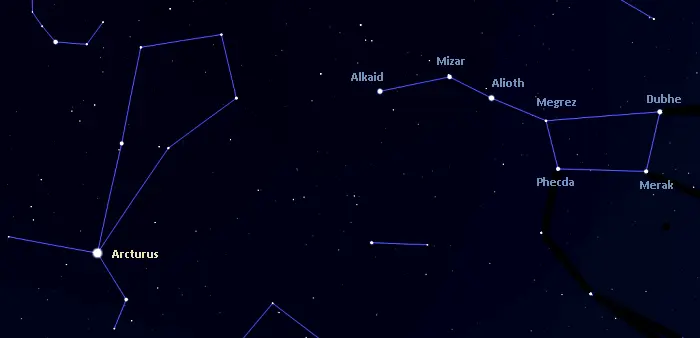
The location of Arcturus, image: Stellarium
Arcturus and Spica are both part of the Spring Triangle and the Great Diamond of Virgo, two asterisms that are prominent in the sky during the northern hemisphere spring. The third vertex of the Spring Triangle is marked by the bright Regulus in the constellation Leo. Sometimes the asterism is taken to be the smaller, more equilateral triangle formed by Arcturus, Spica and Denebola in Leo.
The Great Diamond (or the Diamond of Virgo) is formed by Arcturus, Spica, Cor Caroli in the constellation Canes Venatici and Denebola in Leo. The region inside the asterism is a popular target for telescopes because it contains the Virgo Cluster of galaxies, whose centre is located about halfway from Denebola to Vindemiatrix in Virgo.
Several faint galaxies with IC and NGC designations appear near Arcturus in the sky: the spiral galaxy IC 983 and the lenticular IC 982, the radio galaxy NGC 5490, and the spiral NGC 5490C. The galaxies lie southwest of the star. The brightest of these, IC 983, has an apparent magnitude of 14.3.
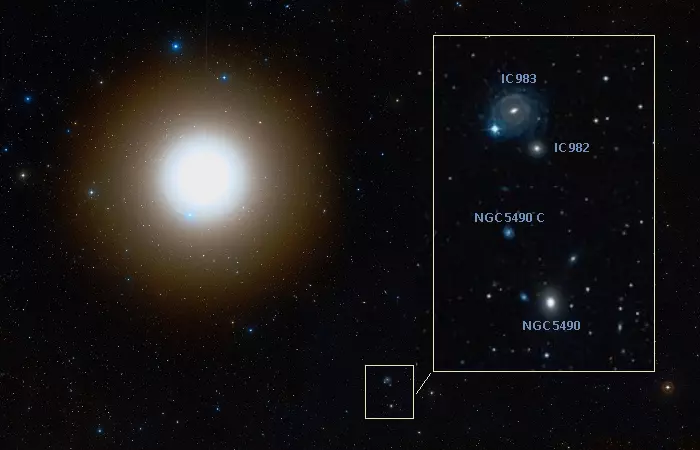
Galaxies appearing near Arcturus, image: Wikisky
Arcturus can also be used to find the telescopic asterism known as Napoleon’s Hat or Picot 1. The asterism appears 40 arcminutes south-southwest of the star. It consists of seven stars that outline the shape of a hat. The stars have apparent magnitudes from 9.5 to 10.7.
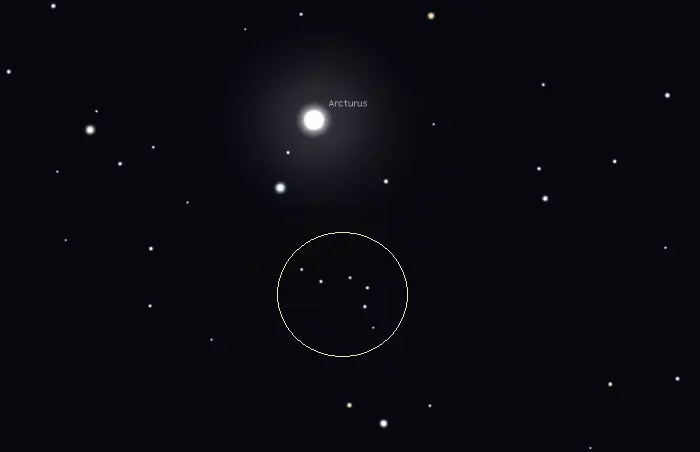
Arcturus and Napoleon’s Hat (Picot 1), image: Stellarium
Arcturus lies 19 degrees north of the celestial equator, which means that it can be seen from both hemispheres, virtually from any inhabited location on Earth. It culminates at 9 pm on June 10 and at midnight on April 27, but it can be seen high in the sky throughout the northern hemisphere spring. In southern latitudes, it marks the beginning of autumn.
Constellation
Arcturus is located in the constellation Boötes, the Herdsman. It marks the Herdsman’s left foot. Boötes is the 13th largest of the 88 constellations, spread across an area of 907 square degrees of the northern sky. The entire constellation is visible to all observers north of latitude 50° S. First mentioned by its name in Homer’s Odyssey, the constellation has been known since ancient times. It is one of the 48 Greek constellations, listed by Ptolemy in his Almagest in the 2nd century CE.
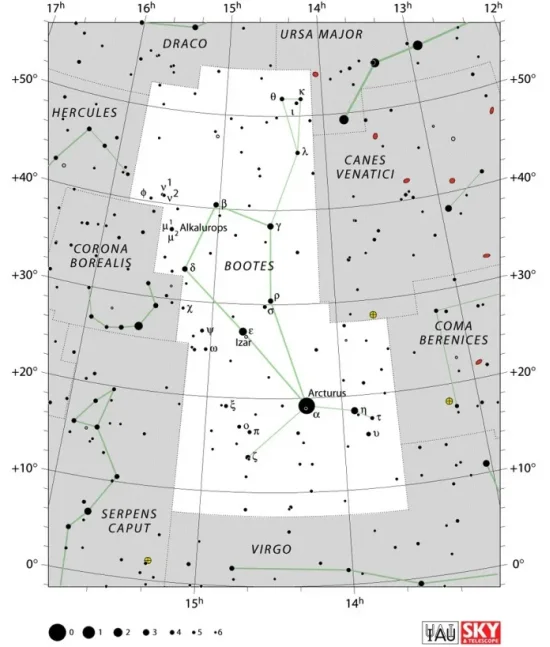
Boötes constellation map by IAU and Sky&Telescope magazine
Boötes is home to a number of popular telescope targets, including the multiple stars Izar (Epsilon Boötis) and Alkalurops (Mu Boötis), the globular cluster NGC 5466, the spiral galaxies NGC 5248 and NGC 5676, and the lenticular galaxy NGC 5548.
The best time of year to observe the stars and deep sky objects in the constellation is during the month of June, when the constellation is high above the horizon in the evening. The entire constellation is visible from locations north of the latitude 50° S.
The 10 brightest stars in Boötes are Arcturus (Alpha Boo, mag. -0.05), Izar (Epsilon Boo, mag. 2.37), Muphrid (Eta Boo, mag. 2.68), Seginus (Gamma Boo, mag. 3.03), Delta Boötis (mag. 3.482), Nekkar (Beta Boo, mag. 3.488), Rho Boötis (mag. 3.59), Zeta Boötis (mag. 3.78), Theta Boötis (mag. 4.02), and Upsilon Boötis (mag. 4.023).
Arcturus – Alpha Boötis
| Spectral class | K1.5IIIFe-0.5 |
| U-B colour index | +1.28 |
| B-V colour index | +1.23 |
| R-I colour index | +0.65 |
| Apparent magnitude (V) | -0.05 |
| Apparent magnitude (J) | -2.25 |
| Absolute magnitude | −0.30 ± 0.02 |
| Distance | 36.7 ± 0.2 light years (11.26 ± 0.07 parsecs) |
| Parallax | 88.83 ± 0.54 mas |
| Radial velocity | -5.229 ± 0.0002 km/s |
| Proper motion | RA: -1,093.45 mas/yr |
| Dec.: -1,999.40 mas/yr | |
| Mass | 1.08 ± 0.06 M☉ |
| Luminosity | 170 L☉ |
| Radius | 25.4 ± 0.2 R☉ |
| Temperature | 4,286 ± 3 K |
| Metallicity | −0.52 ± 0.04 dex |
| Age | 7.1 billion years (5.9 – 8.6 billion years) |
| Rotational velocity | 2.4 ± 1.0 km/s |
| Surface gravity | 1.66 ± 0.05 cgs |
| Constellation | Boötes |
| Right ascension | 14h 15m 39.67207s |
| Declination | +19° 10′ 56.6730” |
| Designations | Arcturus, Alpha Boötis, α Boo, 16 Boötis, HD 124897, HR 5340, HIP 69673, GJ 541, GCTP 3242.00, SAO 100944, LHS 48, BD+19° 2777, AG+19 1335, CCDM J14157+1911A, FK5 526, GC 19242, GCRV 8341, IRAS 14133+1925, LTT 14184, NLTT 36756, 2MASS J14153968+1910558, PPM 130442, PLX 3242.00, TYC 1472-1436-1, AAVSO 1411+19, WDS J14157+1911A |